ICT for Sustainable Cities: Communication & Development Strategies
VerifiedAdded on 2023/04/23
|23
|5650
|322
Essay
AI Summary
This essay discusses the increasing rate of urbanization and the sustainability issues that arise from it, emphasizing the need for investments in sustainable cities and the revitalization of existing ones. It highlights the role of technology, particularly ICT, in achieving these goals by providing a more economical, environmentally sustainable, and socially inclusive operating model. The essay covers the implications of urbanization, including challenges related to water, transportation, electricity, pollution, and poverty, and proposes solutions such as constructing environmentally friendly cities, ensuring essential services, creating more jobs, and controlling population growth. It further elaborates on the fundamental technologies that contribute to smart and sustainable cities, such as advanced materials, electronics, sensors, and integrated networks, and provides examples of cities that have successfully implemented these technologies. The essay concludes by emphasizing the importance of considering a global perspective and the entire life-cycle of services and products when addressing the social and environmental aspects of sustainability.
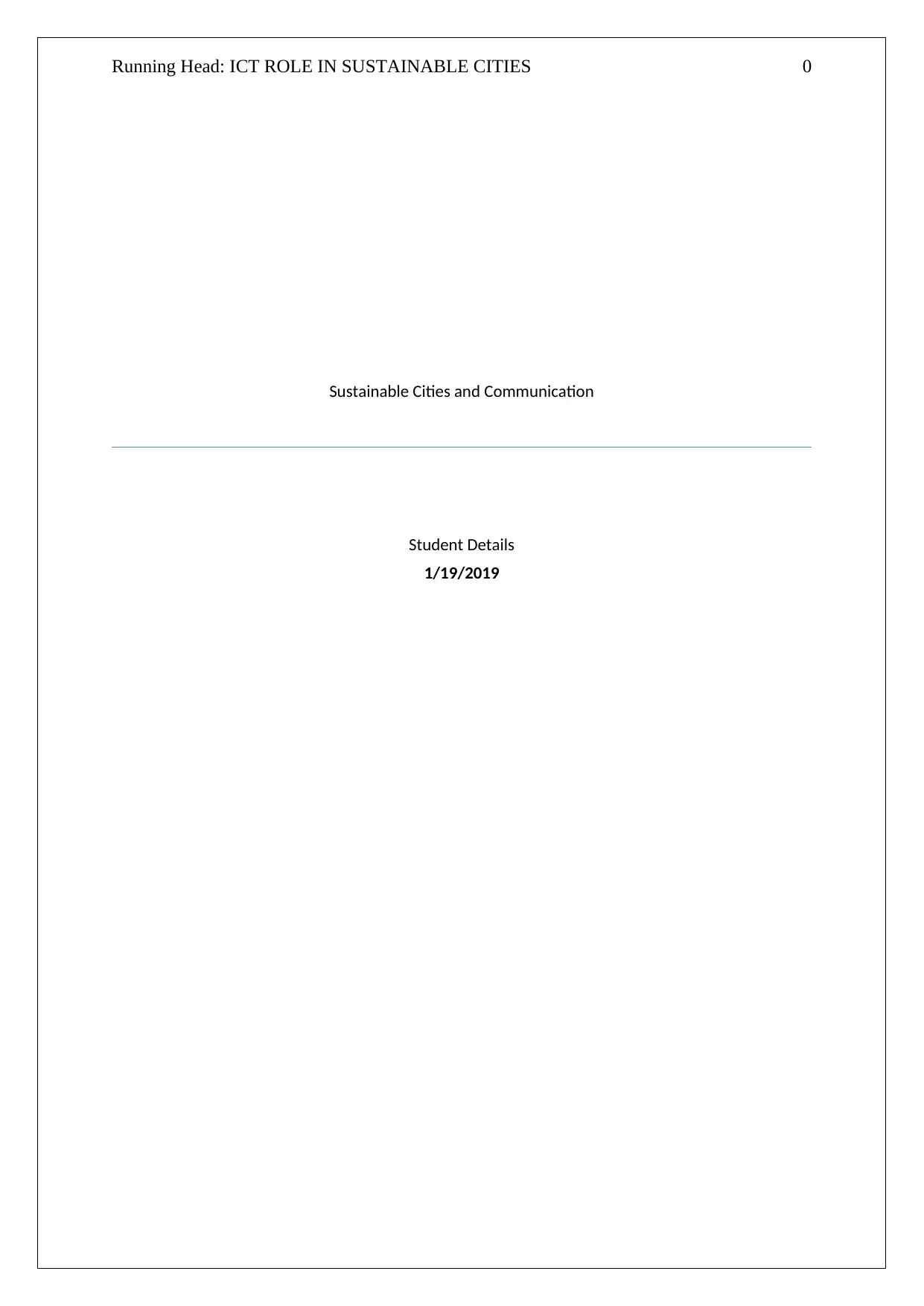
Running Head: ICT ROLE IN SUSTAINABLE CITIES 0
Sustainable Cities and Communication
Student Details
1/19/2019
Sustainable Cities and Communication
Student Details
1/19/2019
Paraphrase This Document
Need a fresh take? Get an instant paraphrase of this document with our AI Paraphraser
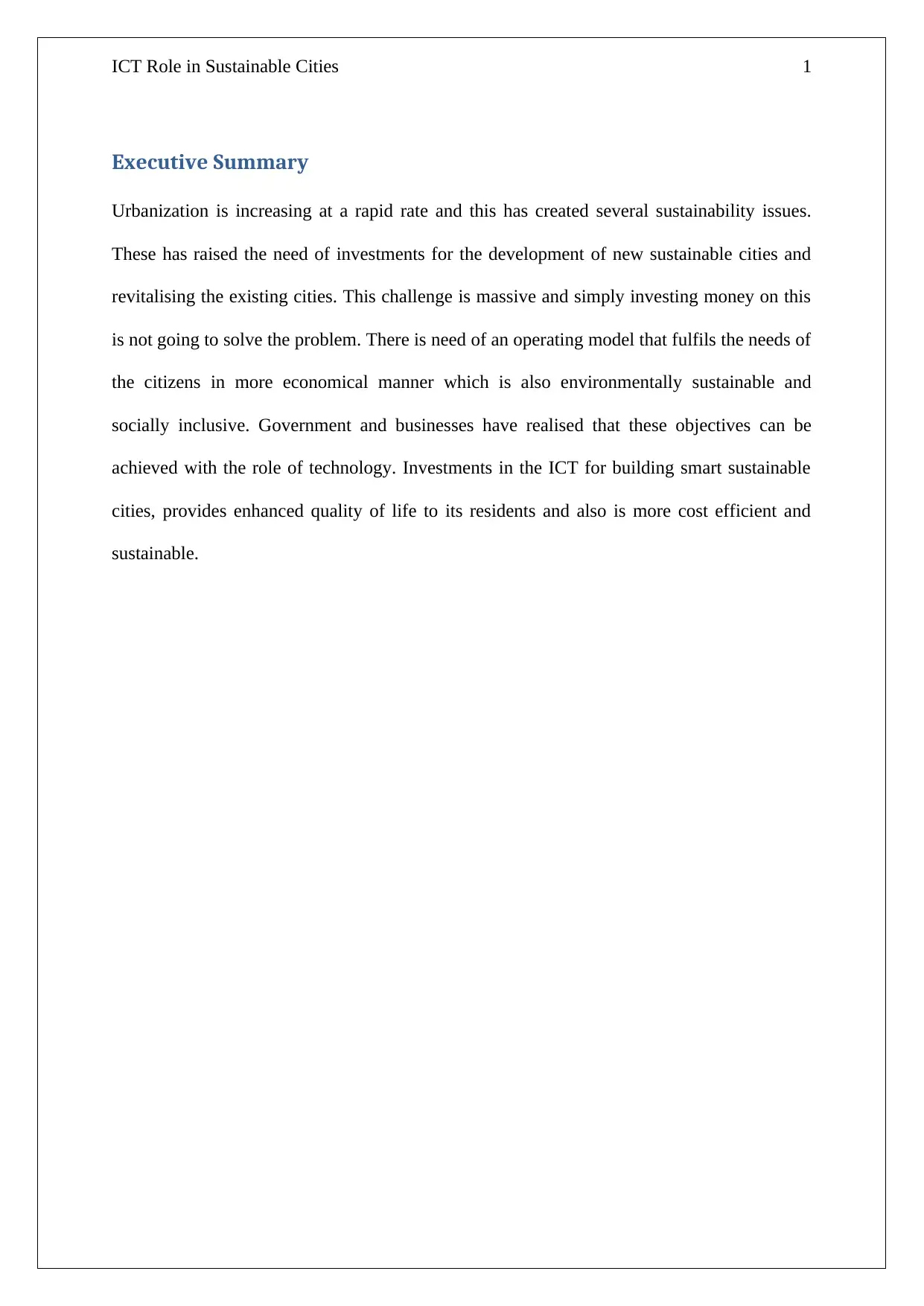
ICT Role in Sustainable Cities 1
Executive Summary
Urbanization is increasing at a rapid rate and this has created several sustainability issues.
These has raised the need of investments for the development of new sustainable cities and
revitalising the existing cities. This challenge is massive and simply investing money on this
is not going to solve the problem. There is need of an operating model that fulfils the needs of
the citizens in more economical manner which is also environmentally sustainable and
socially inclusive. Government and businesses have realised that these objectives can be
achieved with the role of technology. Investments in the ICT for building smart sustainable
cities, provides enhanced quality of life to its residents and also is more cost efficient and
sustainable.
Executive Summary
Urbanization is increasing at a rapid rate and this has created several sustainability issues.
These has raised the need of investments for the development of new sustainable cities and
revitalising the existing cities. This challenge is massive and simply investing money on this
is not going to solve the problem. There is need of an operating model that fulfils the needs of
the citizens in more economical manner which is also environmentally sustainable and
socially inclusive. Government and businesses have realised that these objectives can be
achieved with the role of technology. Investments in the ICT for building smart sustainable
cities, provides enhanced quality of life to its residents and also is more cost efficient and
sustainable.
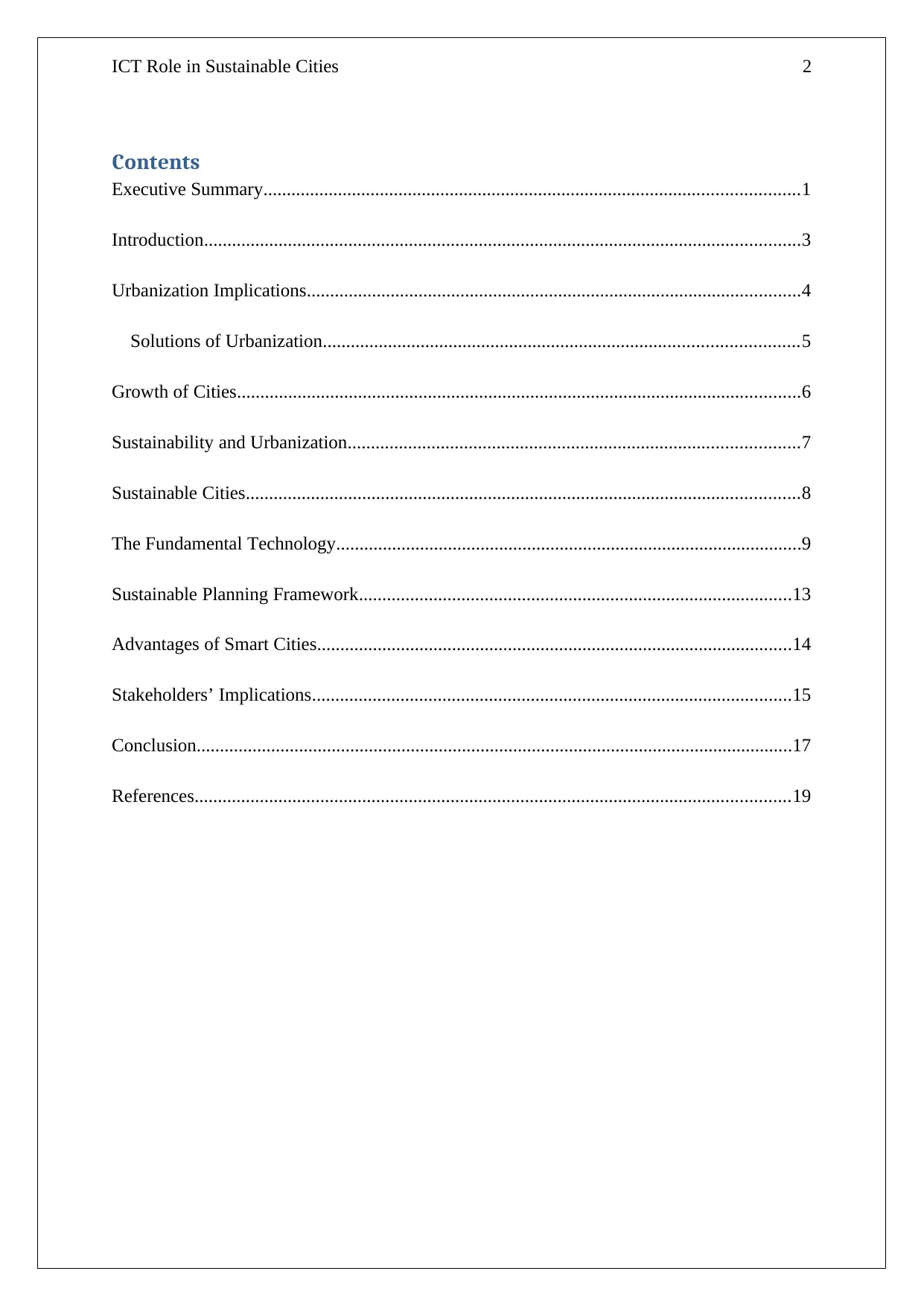
ICT Role in Sustainable Cities 2
Contents
Executive Summary...................................................................................................................1
Introduction................................................................................................................................3
Urbanization Implications..........................................................................................................4
Solutions of Urbanization......................................................................................................5
Growth of Cities.........................................................................................................................6
Sustainability and Urbanization.................................................................................................7
Sustainable Cities.......................................................................................................................8
The Fundamental Technology....................................................................................................9
Sustainable Planning Framework.............................................................................................13
Advantages of Smart Cities......................................................................................................14
Stakeholders’ Implications.......................................................................................................15
Conclusion................................................................................................................................17
References................................................................................................................................19
Contents
Executive Summary...................................................................................................................1
Introduction................................................................................................................................3
Urbanization Implications..........................................................................................................4
Solutions of Urbanization......................................................................................................5
Growth of Cities.........................................................................................................................6
Sustainability and Urbanization.................................................................................................7
Sustainable Cities.......................................................................................................................8
The Fundamental Technology....................................................................................................9
Sustainable Planning Framework.............................................................................................13
Advantages of Smart Cities......................................................................................................14
Stakeholders’ Implications.......................................................................................................15
Conclusion................................................................................................................................17
References................................................................................................................................19
⊘ This is a preview!⊘
Do you want full access?
Subscribe today to unlock all pages.

Trusted by 1+ million students worldwide
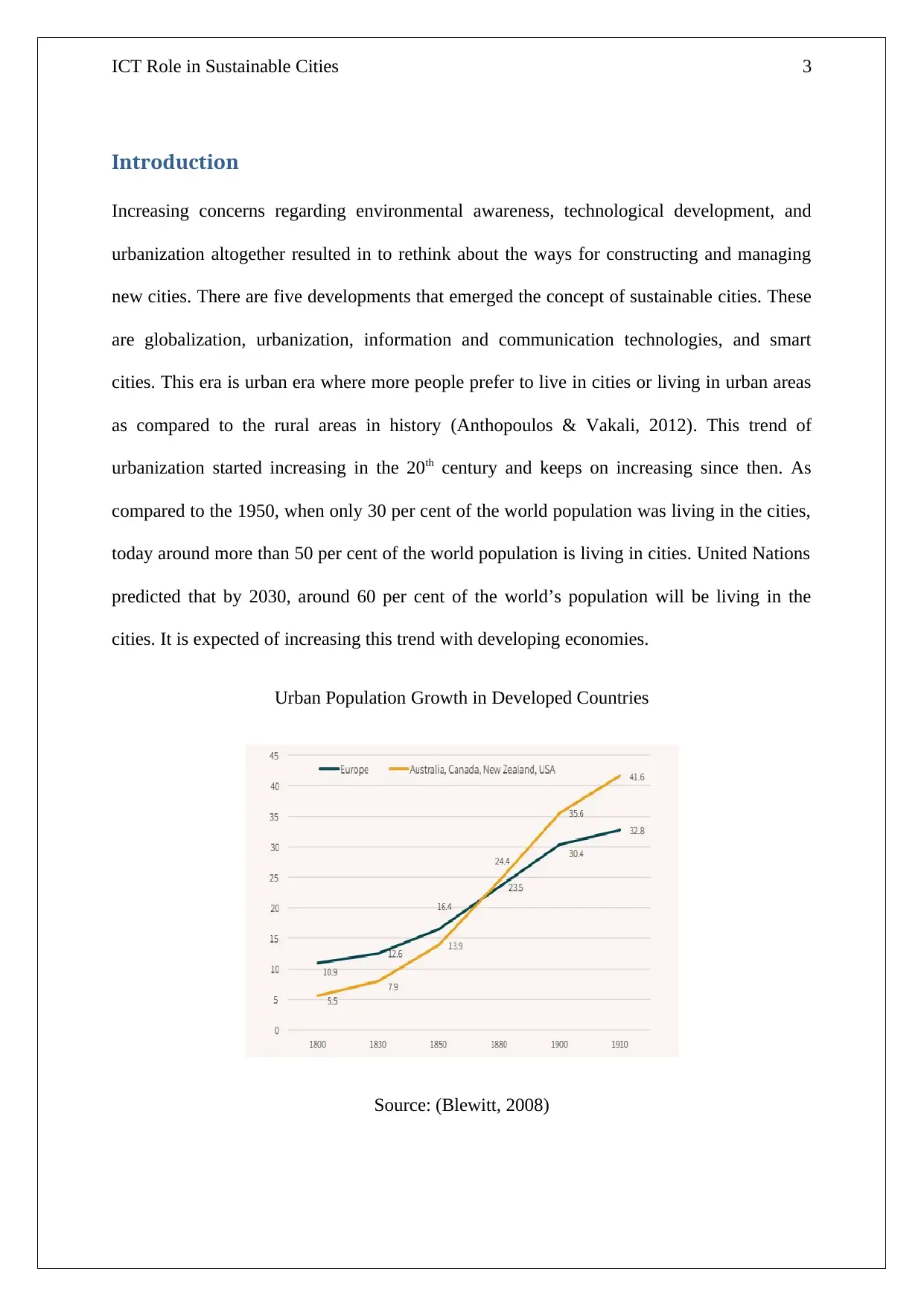
ICT Role in Sustainable Cities 3
Introduction
Increasing concerns regarding environmental awareness, technological development, and
urbanization altogether resulted in to rethink about the ways for constructing and managing
new cities. There are five developments that emerged the concept of sustainable cities. These
are globalization, urbanization, information and communication technologies, and smart
cities. This era is urban era where more people prefer to live in cities or living in urban areas
as compared to the rural areas in history (Anthopoulos & Vakali, 2012). This trend of
urbanization started increasing in the 20th century and keeps on increasing since then. As
compared to the 1950, when only 30 per cent of the world population was living in the cities,
today around more than 50 per cent of the world population is living in cities. United Nations
predicted that by 2030, around 60 per cent of the world’s population will be living in the
cities. It is expected of increasing this trend with developing economies.
Urban Population Growth in Developed Countries
Source: (Blewitt, 2008)
Introduction
Increasing concerns regarding environmental awareness, technological development, and
urbanization altogether resulted in to rethink about the ways for constructing and managing
new cities. There are five developments that emerged the concept of sustainable cities. These
are globalization, urbanization, information and communication technologies, and smart
cities. This era is urban era where more people prefer to live in cities or living in urban areas
as compared to the rural areas in history (Anthopoulos & Vakali, 2012). This trend of
urbanization started increasing in the 20th century and keeps on increasing since then. As
compared to the 1950, when only 30 per cent of the world population was living in the cities,
today around more than 50 per cent of the world population is living in cities. United Nations
predicted that by 2030, around 60 per cent of the world’s population will be living in the
cities. It is expected of increasing this trend with developing economies.
Urban Population Growth in Developed Countries
Source: (Blewitt, 2008)
Paraphrase This Document
Need a fresh take? Get an instant paraphrase of this document with our AI Paraphraser
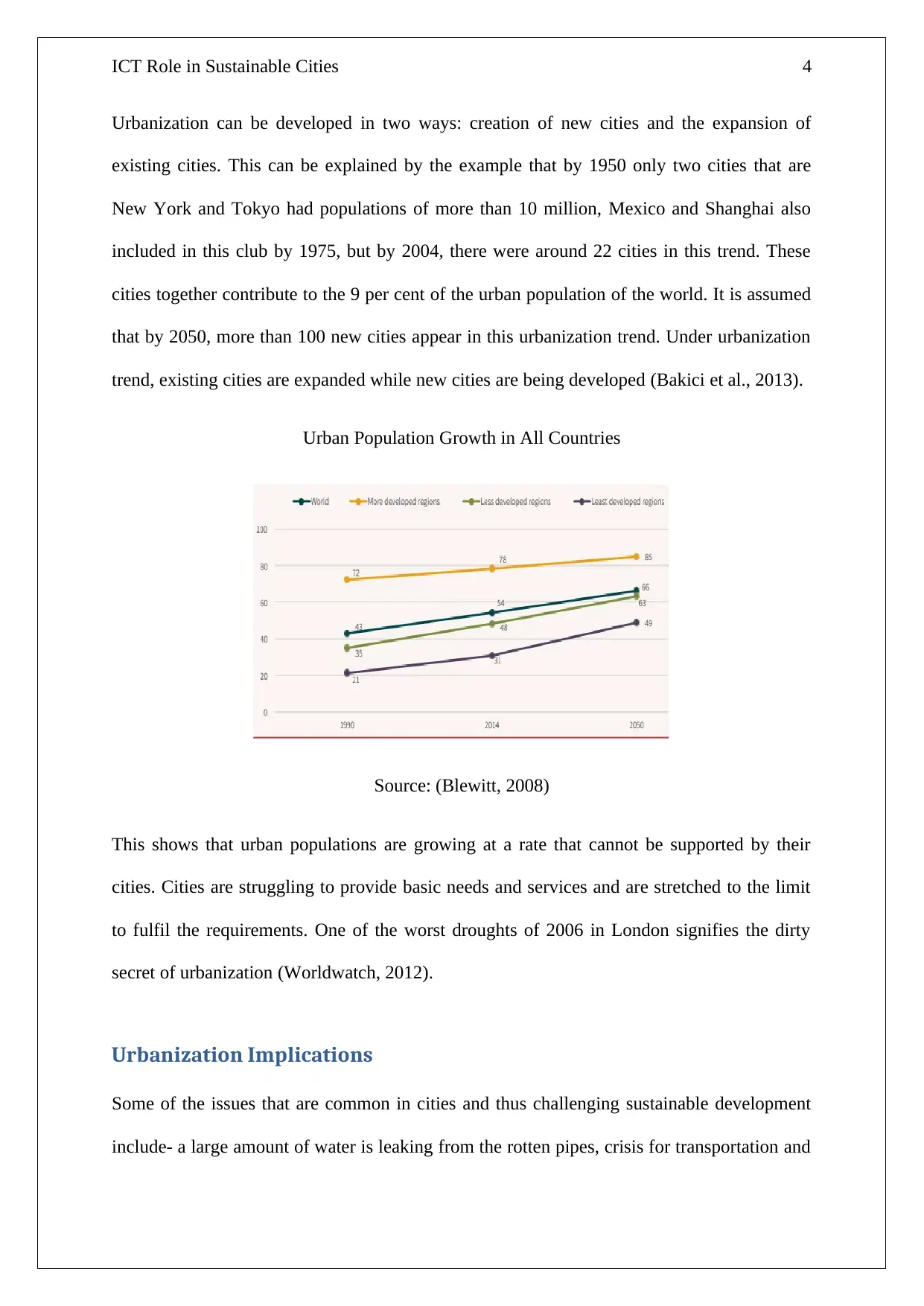
ICT Role in Sustainable Cities 4
Urbanization can be developed in two ways: creation of new cities and the expansion of
existing cities. This can be explained by the example that by 1950 only two cities that are
New York and Tokyo had populations of more than 10 million, Mexico and Shanghai also
included in this club by 1975, but by 2004, there were around 22 cities in this trend. These
cities together contribute to the 9 per cent of the urban population of the world. It is assumed
that by 2050, more than 100 new cities appear in this urbanization trend. Under urbanization
trend, existing cities are expanded while new cities are being developed (Bakici et al., 2013).
Urban Population Growth in All Countries
Source: (Blewitt, 2008)
This shows that urban populations are growing at a rate that cannot be supported by their
cities. Cities are struggling to provide basic needs and services and are stretched to the limit
to fulfil the requirements. One of the worst droughts of 2006 in London signifies the dirty
secret of urbanization (Worldwatch, 2012).
Urbanization Implications
Some of the issues that are common in cities and thus challenging sustainable development
include- a large amount of water is leaking from the rotten pipes, crisis for transportation and
Urbanization can be developed in two ways: creation of new cities and the expansion of
existing cities. This can be explained by the example that by 1950 only two cities that are
New York and Tokyo had populations of more than 10 million, Mexico and Shanghai also
included in this club by 1975, but by 2004, there were around 22 cities in this trend. These
cities together contribute to the 9 per cent of the urban population of the world. It is assumed
that by 2050, more than 100 new cities appear in this urbanization trend. Under urbanization
trend, existing cities are expanded while new cities are being developed (Bakici et al., 2013).
Urban Population Growth in All Countries
Source: (Blewitt, 2008)
This shows that urban populations are growing at a rate that cannot be supported by their
cities. Cities are struggling to provide basic needs and services and are stretched to the limit
to fulfil the requirements. One of the worst droughts of 2006 in London signifies the dirty
secret of urbanization (Worldwatch, 2012).
Urbanization Implications
Some of the issues that are common in cities and thus challenging sustainable development
include- a large amount of water is leaking from the rotten pipes, crisis for transportation and
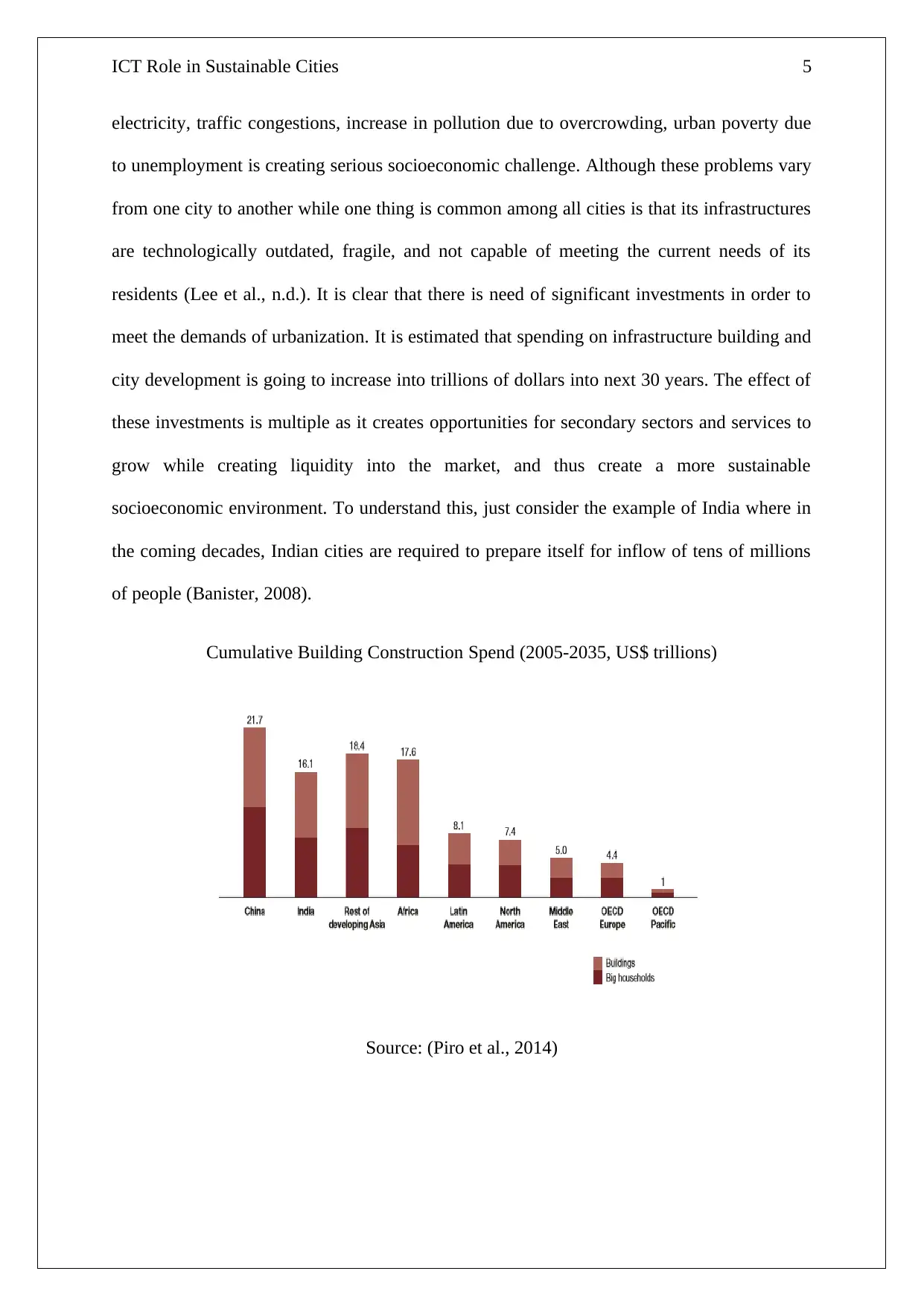
ICT Role in Sustainable Cities 5
electricity, traffic congestions, increase in pollution due to overcrowding, urban poverty due
to unemployment is creating serious socioeconomic challenge. Although these problems vary
from one city to another while one thing is common among all cities is that its infrastructures
are technologically outdated, fragile, and not capable of meeting the current needs of its
residents (Lee et al., n.d.). It is clear that there is need of significant investments in order to
meet the demands of urbanization. It is estimated that spending on infrastructure building and
city development is going to increase into trillions of dollars into next 30 years. The effect of
these investments is multiple as it creates opportunities for secondary sectors and services to
grow while creating liquidity into the market, and thus create a more sustainable
socioeconomic environment. To understand this, just consider the example of India where in
the coming decades, Indian cities are required to prepare itself for inflow of tens of millions
of people (Banister, 2008).
Cumulative Building Construction Spend (2005-2035, US$ trillions)
Source: (Piro et al., 2014)
electricity, traffic congestions, increase in pollution due to overcrowding, urban poverty due
to unemployment is creating serious socioeconomic challenge. Although these problems vary
from one city to another while one thing is common among all cities is that its infrastructures
are technologically outdated, fragile, and not capable of meeting the current needs of its
residents (Lee et al., n.d.). It is clear that there is need of significant investments in order to
meet the demands of urbanization. It is estimated that spending on infrastructure building and
city development is going to increase into trillions of dollars into next 30 years. The effect of
these investments is multiple as it creates opportunities for secondary sectors and services to
grow while creating liquidity into the market, and thus create a more sustainable
socioeconomic environment. To understand this, just consider the example of India where in
the coming decades, Indian cities are required to prepare itself for inflow of tens of millions
of people (Banister, 2008).
Cumulative Building Construction Spend (2005-2035, US$ trillions)
Source: (Piro et al., 2014)
⊘ This is a preview!⊘
Do you want full access?
Subscribe today to unlock all pages.

Trusted by 1+ million students worldwide
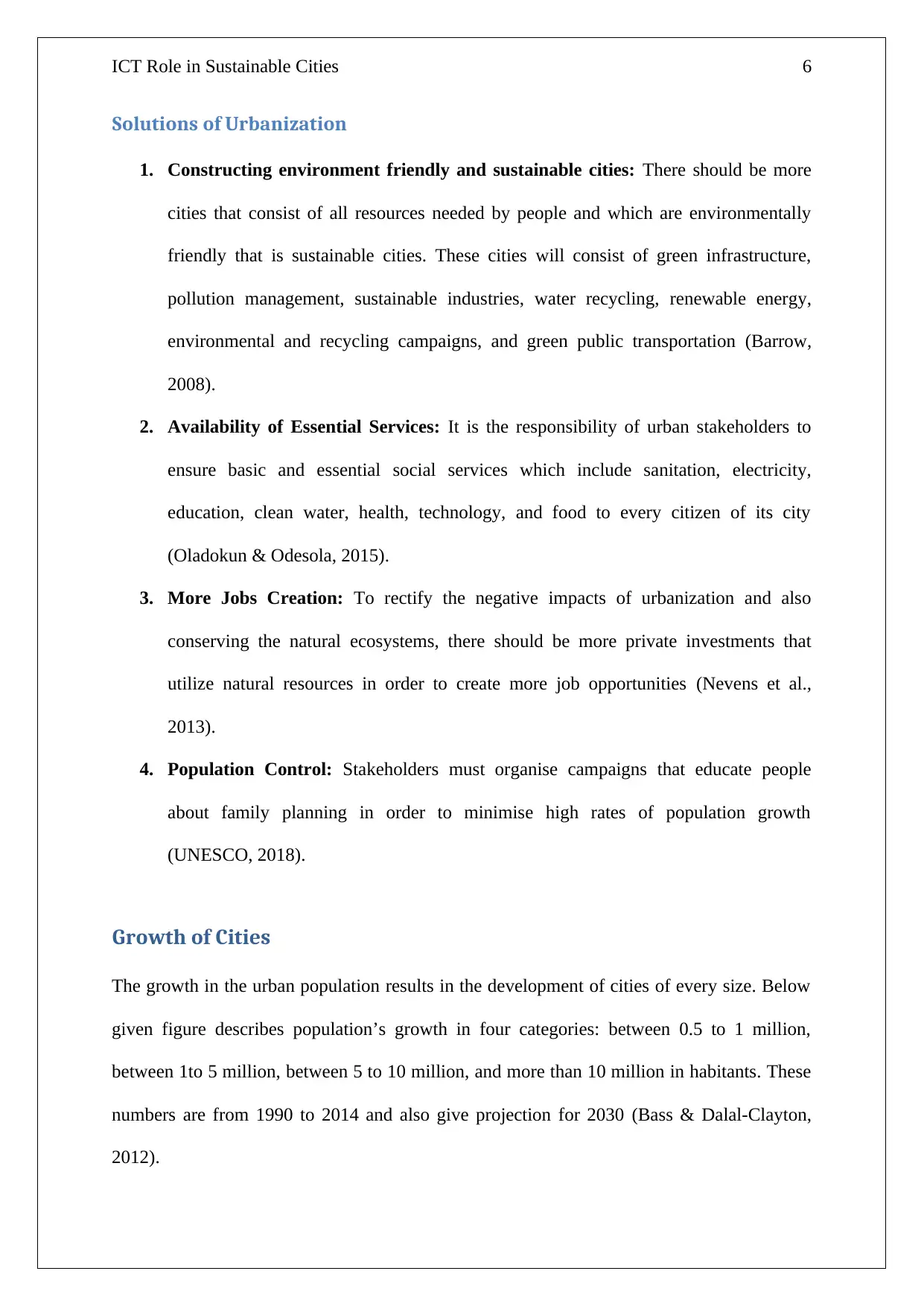
ICT Role in Sustainable Cities 6
Solutions of Urbanization
1. Constructing environment friendly and sustainable cities: There should be more
cities that consist of all resources needed by people and which are environmentally
friendly that is sustainable cities. These cities will consist of green infrastructure,
pollution management, sustainable industries, water recycling, renewable energy,
environmental and recycling campaigns, and green public transportation (Barrow,
2008).
2. Availability of Essential Services: It is the responsibility of urban stakeholders to
ensure basic and essential social services which include sanitation, electricity,
education, clean water, health, technology, and food to every citizen of its city
(Oladokun & Odesola, 2015).
3. More Jobs Creation: To rectify the negative impacts of urbanization and also
conserving the natural ecosystems, there should be more private investments that
utilize natural resources in order to create more job opportunities (Nevens et al.,
2013).
4. Population Control: Stakeholders must organise campaigns that educate people
about family planning in order to minimise high rates of population growth
(UNESCO, 2018).
Growth of Cities
The growth in the urban population results in the development of cities of every size. Below
given figure describes population’s growth in four categories: between 0.5 to 1 million,
between 1to 5 million, between 5 to 10 million, and more than 10 million in habitants. These
numbers are from 1990 to 2014 and also give projection for 2030 (Bass & Dalal-Clayton,
2012).
Solutions of Urbanization
1. Constructing environment friendly and sustainable cities: There should be more
cities that consist of all resources needed by people and which are environmentally
friendly that is sustainable cities. These cities will consist of green infrastructure,
pollution management, sustainable industries, water recycling, renewable energy,
environmental and recycling campaigns, and green public transportation (Barrow,
2008).
2. Availability of Essential Services: It is the responsibility of urban stakeholders to
ensure basic and essential social services which include sanitation, electricity,
education, clean water, health, technology, and food to every citizen of its city
(Oladokun & Odesola, 2015).
3. More Jobs Creation: To rectify the negative impacts of urbanization and also
conserving the natural ecosystems, there should be more private investments that
utilize natural resources in order to create more job opportunities (Nevens et al.,
2013).
4. Population Control: Stakeholders must organise campaigns that educate people
about family planning in order to minimise high rates of population growth
(UNESCO, 2018).
Growth of Cities
The growth in the urban population results in the development of cities of every size. Below
given figure describes population’s growth in four categories: between 0.5 to 1 million,
between 1to 5 million, between 5 to 10 million, and more than 10 million in habitants. These
numbers are from 1990 to 2014 and also give projection for 2030 (Bass & Dalal-Clayton,
2012).
Paraphrase This Document
Need a fresh take? Get an instant paraphrase of this document with our AI Paraphraser
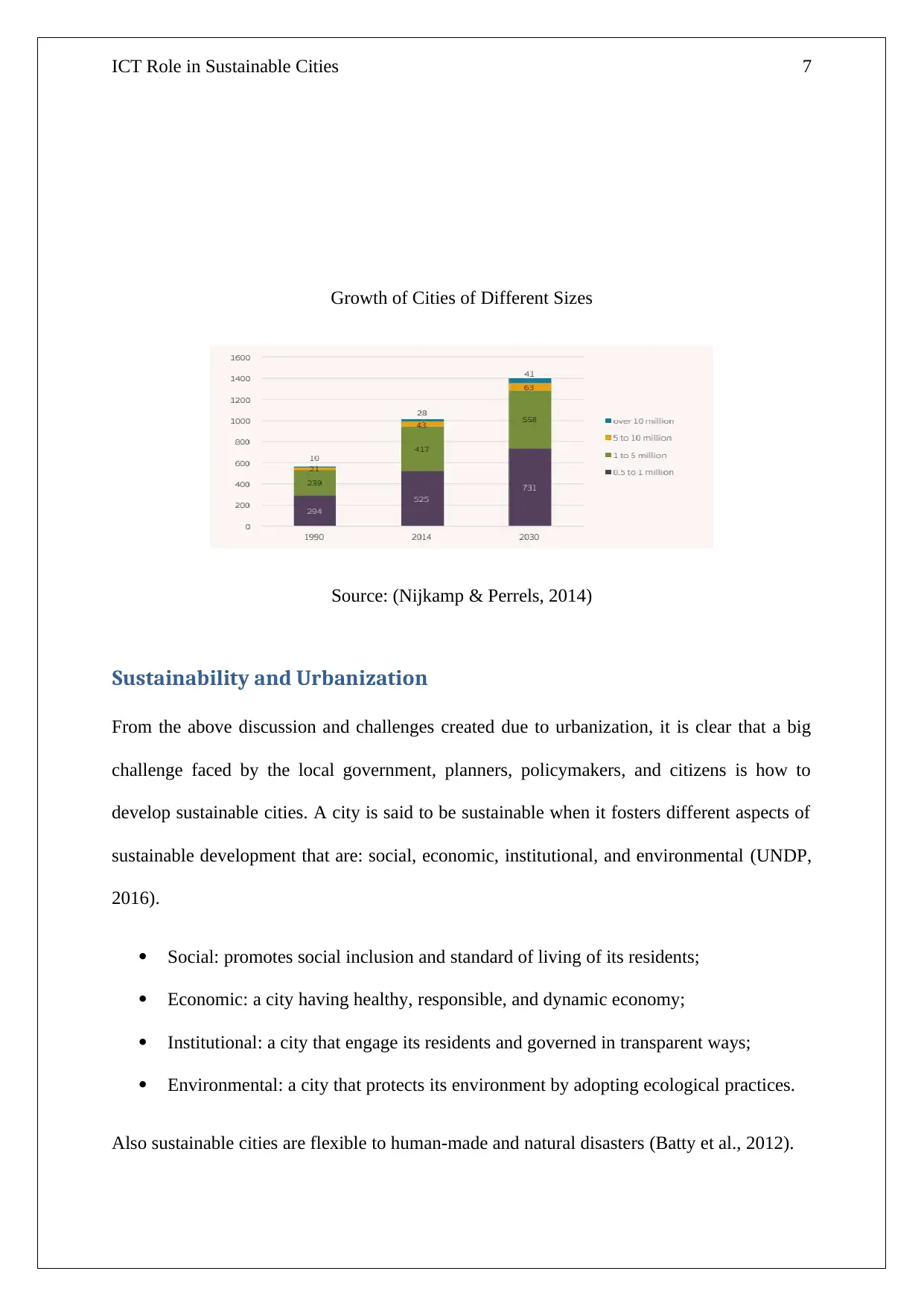
ICT Role in Sustainable Cities 7
Growth of Cities of Different Sizes
Source: (Nijkamp & Perrels, 2014)
Sustainability and Urbanization
From the above discussion and challenges created due to urbanization, it is clear that a big
challenge faced by the local government, planners, policymakers, and citizens is how to
develop sustainable cities. A city is said to be sustainable when it fosters different aspects of
sustainable development that are: social, economic, institutional, and environmental (UNDP,
2016).
Social: promotes social inclusion and standard of living of its residents;
Economic: a city having healthy, responsible, and dynamic economy;
Institutional: a city that engage its residents and governed in transparent ways;
Environmental: a city that protects its environment by adopting ecological practices.
Also sustainable cities are flexible to human-made and natural disasters (Batty et al., 2012).
Growth of Cities of Different Sizes
Source: (Nijkamp & Perrels, 2014)
Sustainability and Urbanization
From the above discussion and challenges created due to urbanization, it is clear that a big
challenge faced by the local government, planners, policymakers, and citizens is how to
develop sustainable cities. A city is said to be sustainable when it fosters different aspects of
sustainable development that are: social, economic, institutional, and environmental (UNDP,
2016).
Social: promotes social inclusion and standard of living of its residents;
Economic: a city having healthy, responsible, and dynamic economy;
Institutional: a city that engage its residents and governed in transparent ways;
Environmental: a city that protects its environment by adopting ecological practices.
Also sustainable cities are flexible to human-made and natural disasters (Batty et al., 2012).
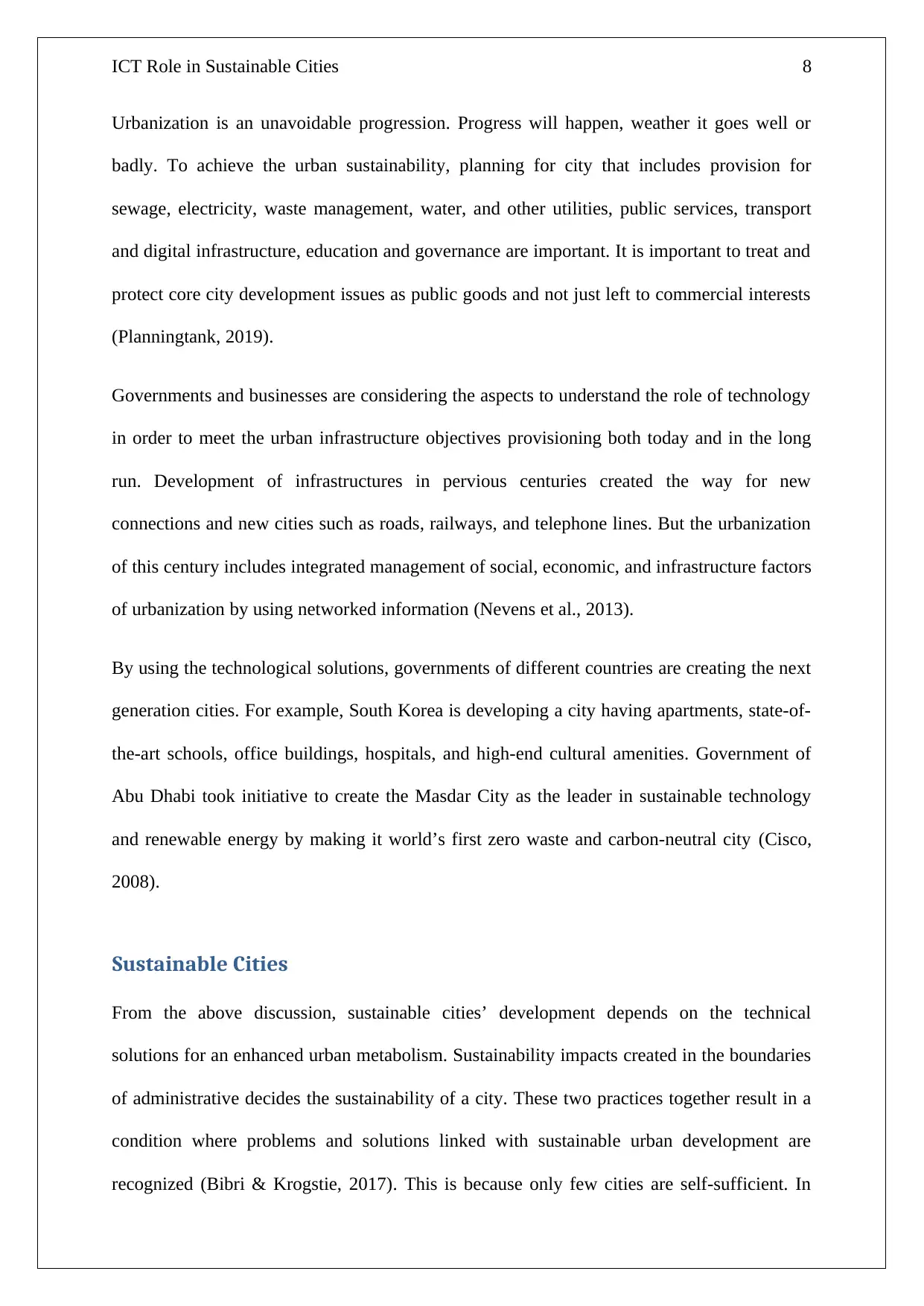
ICT Role in Sustainable Cities 8
Urbanization is an unavoidable progression. Progress will happen, weather it goes well or
badly. To achieve the urban sustainability, planning for city that includes provision for
sewage, electricity, waste management, water, and other utilities, public services, transport
and digital infrastructure, education and governance are important. It is important to treat and
protect core city development issues as public goods and not just left to commercial interests
(Planningtank, 2019).
Governments and businesses are considering the aspects to understand the role of technology
in order to meet the urban infrastructure objectives provisioning both today and in the long
run. Development of infrastructures in pervious centuries created the way for new
connections and new cities such as roads, railways, and telephone lines. But the urbanization
of this century includes integrated management of social, economic, and infrastructure factors
of urbanization by using networked information (Nevens et al., 2013).
By using the technological solutions, governments of different countries are creating the next
generation cities. For example, South Korea is developing a city having apartments, state-of-
the-art schools, office buildings, hospitals, and high-end cultural amenities. Government of
Abu Dhabi took initiative to create the Masdar City as the leader in sustainable technology
and renewable energy by making it world’s first zero waste and carbon-neutral city (Cisco,
2008).
Sustainable Cities
From the above discussion, sustainable cities’ development depends on the technical
solutions for an enhanced urban metabolism. Sustainability impacts created in the boundaries
of administrative decides the sustainability of a city. These two practices together result in a
condition where problems and solutions linked with sustainable urban development are
recognized (Bibri & Krogstie, 2017). This is because only few cities are self-sufficient. In
Urbanization is an unavoidable progression. Progress will happen, weather it goes well or
badly. To achieve the urban sustainability, planning for city that includes provision for
sewage, electricity, waste management, water, and other utilities, public services, transport
and digital infrastructure, education and governance are important. It is important to treat and
protect core city development issues as public goods and not just left to commercial interests
(Planningtank, 2019).
Governments and businesses are considering the aspects to understand the role of technology
in order to meet the urban infrastructure objectives provisioning both today and in the long
run. Development of infrastructures in pervious centuries created the way for new
connections and new cities such as roads, railways, and telephone lines. But the urbanization
of this century includes integrated management of social, economic, and infrastructure factors
of urbanization by using networked information (Nevens et al., 2013).
By using the technological solutions, governments of different countries are creating the next
generation cities. For example, South Korea is developing a city having apartments, state-of-
the-art schools, office buildings, hospitals, and high-end cultural amenities. Government of
Abu Dhabi took initiative to create the Masdar City as the leader in sustainable technology
and renewable energy by making it world’s first zero waste and carbon-neutral city (Cisco,
2008).
Sustainable Cities
From the above discussion, sustainable cities’ development depends on the technical
solutions for an enhanced urban metabolism. Sustainability impacts created in the boundaries
of administrative decides the sustainability of a city. These two practices together result in a
condition where problems and solutions linked with sustainable urban development are
recognized (Bibri & Krogstie, 2017). This is because only few cities are self-sufficient. In
⊘ This is a preview!⊘
Do you want full access?
Subscribe today to unlock all pages.

Trusted by 1+ million students worldwide
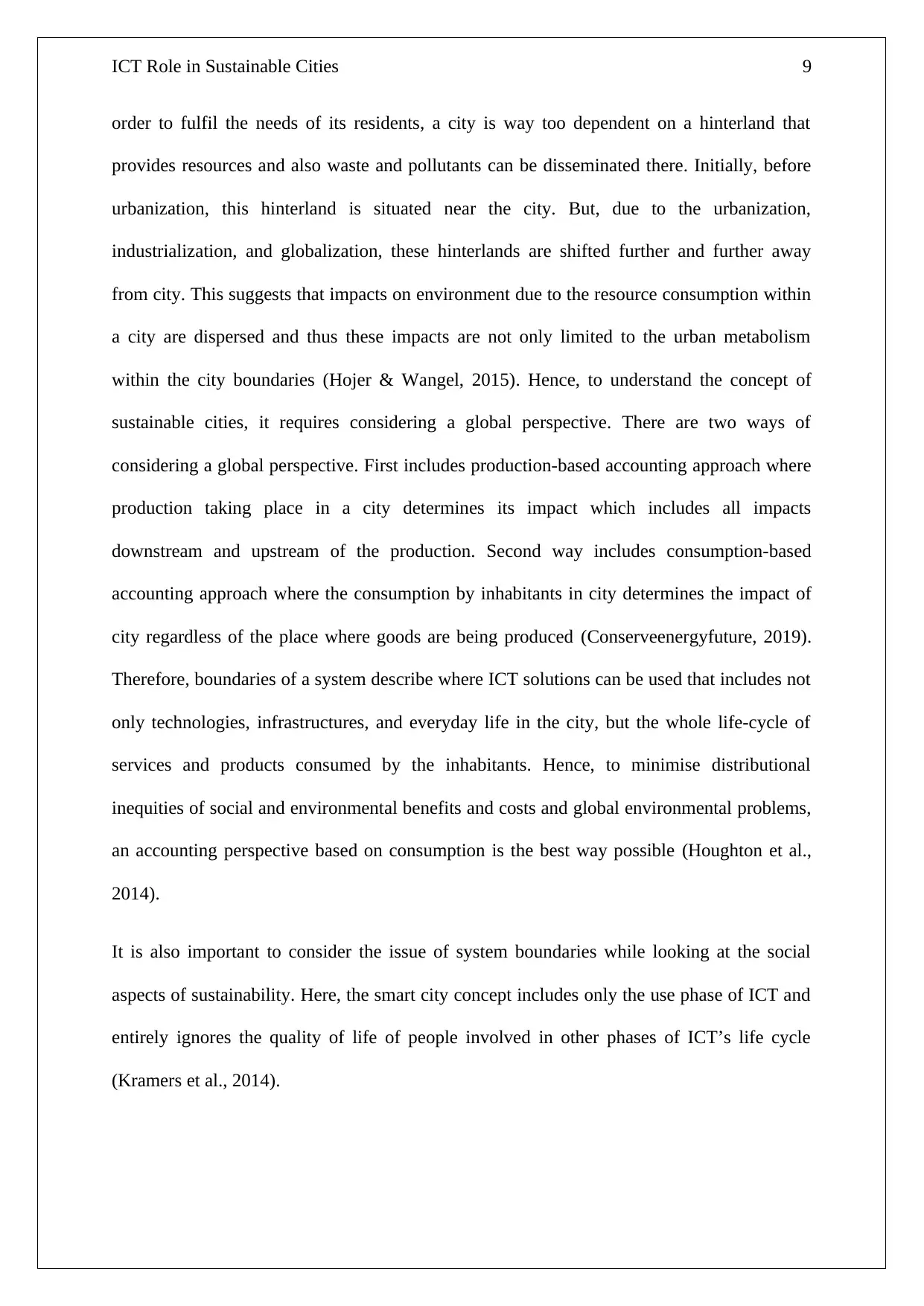
ICT Role in Sustainable Cities 9
order to fulfil the needs of its residents, a city is way too dependent on a hinterland that
provides resources and also waste and pollutants can be disseminated there. Initially, before
urbanization, this hinterland is situated near the city. But, due to the urbanization,
industrialization, and globalization, these hinterlands are shifted further and further away
from city. This suggests that impacts on environment due to the resource consumption within
a city are dispersed and thus these impacts are not only limited to the urban metabolism
within the city boundaries (Hojer & Wangel, 2015). Hence, to understand the concept of
sustainable cities, it requires considering a global perspective. There are two ways of
considering a global perspective. First includes production-based accounting approach where
production taking place in a city determines its impact which includes all impacts
downstream and upstream of the production. Second way includes consumption-based
accounting approach where the consumption by inhabitants in city determines the impact of
city regardless of the place where goods are being produced (Conserveenergyfuture, 2019).
Therefore, boundaries of a system describe where ICT solutions can be used that includes not
only technologies, infrastructures, and everyday life in the city, but the whole life-cycle of
services and products consumed by the inhabitants. Hence, to minimise distributional
inequities of social and environmental benefits and costs and global environmental problems,
an accounting perspective based on consumption is the best way possible (Houghton et al.,
2014).
It is also important to consider the issue of system boundaries while looking at the social
aspects of sustainability. Here, the smart city concept includes only the use phase of ICT and
entirely ignores the quality of life of people involved in other phases of ICT’s life cycle
(Kramers et al., 2014).
order to fulfil the needs of its residents, a city is way too dependent on a hinterland that
provides resources and also waste and pollutants can be disseminated there. Initially, before
urbanization, this hinterland is situated near the city. But, due to the urbanization,
industrialization, and globalization, these hinterlands are shifted further and further away
from city. This suggests that impacts on environment due to the resource consumption within
a city are dispersed and thus these impacts are not only limited to the urban metabolism
within the city boundaries (Hojer & Wangel, 2015). Hence, to understand the concept of
sustainable cities, it requires considering a global perspective. There are two ways of
considering a global perspective. First includes production-based accounting approach where
production taking place in a city determines its impact which includes all impacts
downstream and upstream of the production. Second way includes consumption-based
accounting approach where the consumption by inhabitants in city determines the impact of
city regardless of the place where goods are being produced (Conserveenergyfuture, 2019).
Therefore, boundaries of a system describe where ICT solutions can be used that includes not
only technologies, infrastructures, and everyday life in the city, but the whole life-cycle of
services and products consumed by the inhabitants. Hence, to minimise distributional
inequities of social and environmental benefits and costs and global environmental problems,
an accounting perspective based on consumption is the best way possible (Houghton et al.,
2014).
It is also important to consider the issue of system boundaries while looking at the social
aspects of sustainability. Here, the smart city concept includes only the use phase of ICT and
entirely ignores the quality of life of people involved in other phases of ICT’s life cycle
(Kramers et al., 2014).
Paraphrase This Document
Need a fresh take? Get an instant paraphrase of this document with our AI Paraphraser
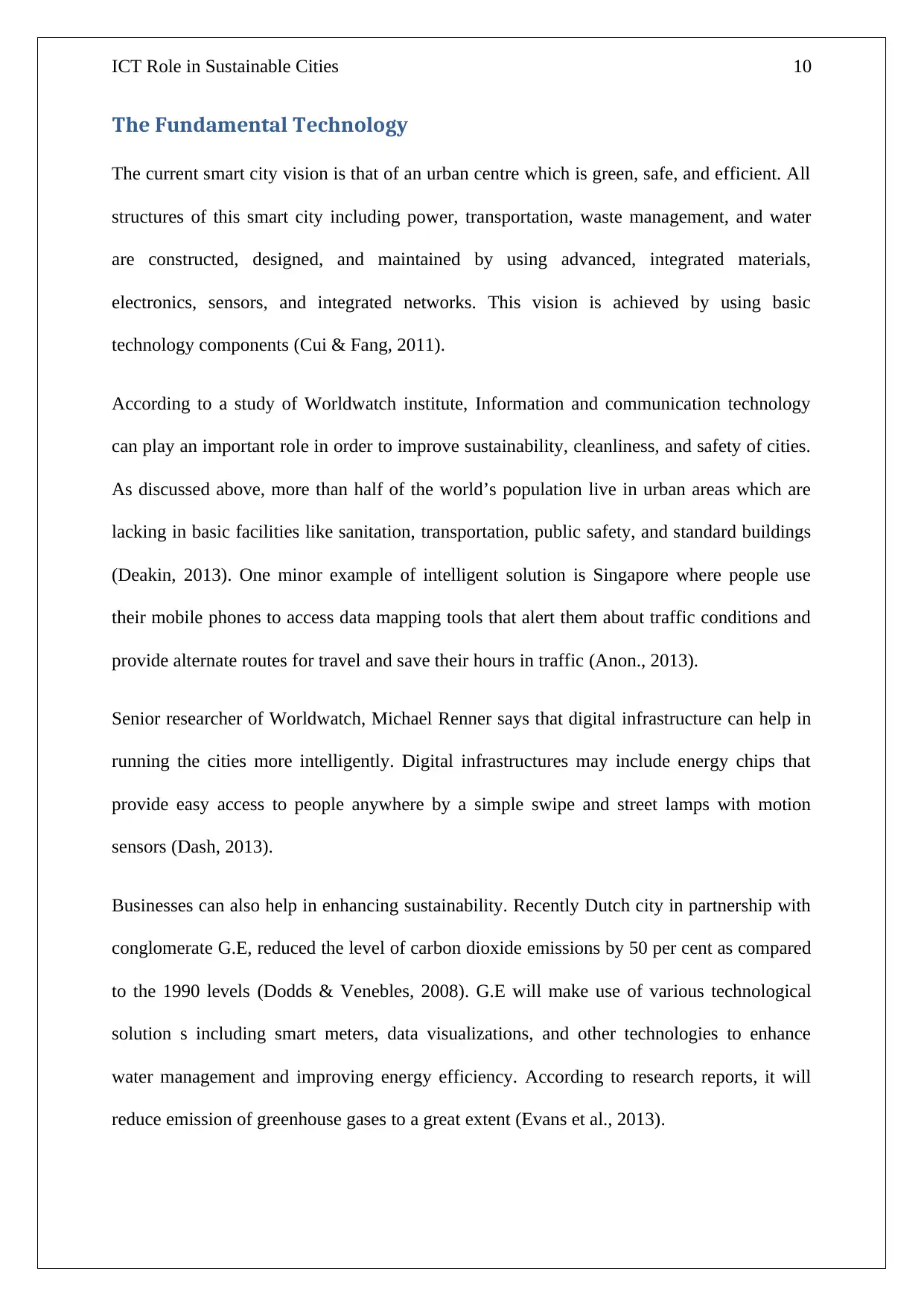
ICT Role in Sustainable Cities 10
The Fundamental Technology
The current smart city vision is that of an urban centre which is green, safe, and efficient. All
structures of this smart city including power, transportation, waste management, and water
are constructed, designed, and maintained by using advanced, integrated materials,
electronics, sensors, and integrated networks. This vision is achieved by using basic
technology components (Cui & Fang, 2011).
According to a study of Worldwatch institute, Information and communication technology
can play an important role in order to improve sustainability, cleanliness, and safety of cities.
As discussed above, more than half of the world’s population live in urban areas which are
lacking in basic facilities like sanitation, transportation, public safety, and standard buildings
(Deakin, 2013). One minor example of intelligent solution is Singapore where people use
their mobile phones to access data mapping tools that alert them about traffic conditions and
provide alternate routes for travel and save their hours in traffic (Anon., 2013).
Senior researcher of Worldwatch, Michael Renner says that digital infrastructure can help in
running the cities more intelligently. Digital infrastructures may include energy chips that
provide easy access to people anywhere by a simple swipe and street lamps with motion
sensors (Dash, 2013).
Businesses can also help in enhancing sustainability. Recently Dutch city in partnership with
conglomerate G.E, reduced the level of carbon dioxide emissions by 50 per cent as compared
to the 1990 levels (Dodds & Venebles, 2008). G.E will make use of various technological
solution s including smart meters, data visualizations, and other technologies to enhance
water management and improving energy efficiency. According to research reports, it will
reduce emission of greenhouse gases to a great extent (Evans et al., 2013).
The Fundamental Technology
The current smart city vision is that of an urban centre which is green, safe, and efficient. All
structures of this smart city including power, transportation, waste management, and water
are constructed, designed, and maintained by using advanced, integrated materials,
electronics, sensors, and integrated networks. This vision is achieved by using basic
technology components (Cui & Fang, 2011).
According to a study of Worldwatch institute, Information and communication technology
can play an important role in order to improve sustainability, cleanliness, and safety of cities.
As discussed above, more than half of the world’s population live in urban areas which are
lacking in basic facilities like sanitation, transportation, public safety, and standard buildings
(Deakin, 2013). One minor example of intelligent solution is Singapore where people use
their mobile phones to access data mapping tools that alert them about traffic conditions and
provide alternate routes for travel and save their hours in traffic (Anon., 2013).
Senior researcher of Worldwatch, Michael Renner says that digital infrastructure can help in
running the cities more intelligently. Digital infrastructures may include energy chips that
provide easy access to people anywhere by a simple swipe and street lamps with motion
sensors (Dash, 2013).
Businesses can also help in enhancing sustainability. Recently Dutch city in partnership with
conglomerate G.E, reduced the level of carbon dioxide emissions by 50 per cent as compared
to the 1990 levels (Dodds & Venebles, 2008). G.E will make use of various technological
solution s including smart meters, data visualizations, and other technologies to enhance
water management and improving energy efficiency. According to research reports, it will
reduce emission of greenhouse gases to a great extent (Evans et al., 2013).
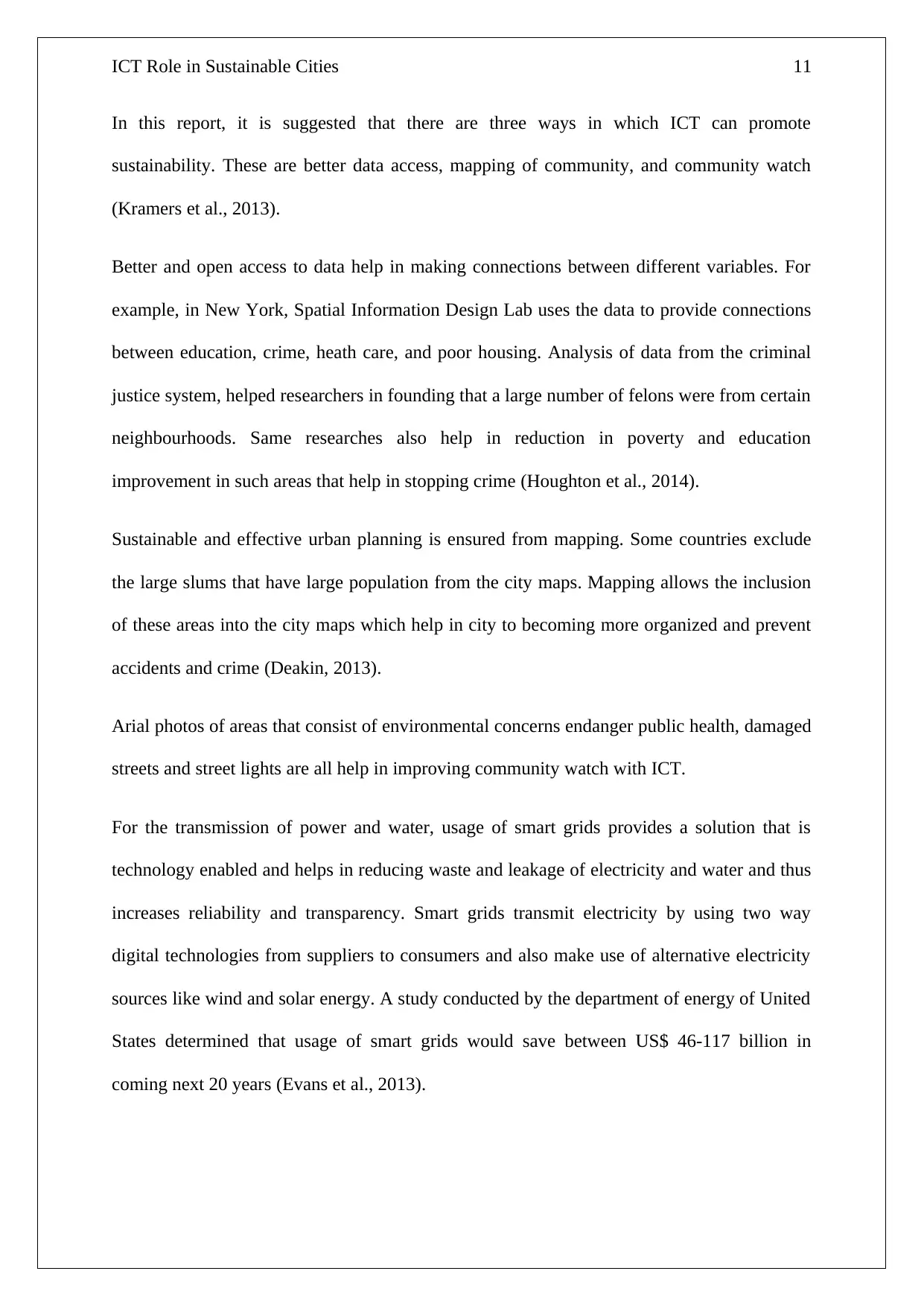
ICT Role in Sustainable Cities 11
In this report, it is suggested that there are three ways in which ICT can promote
sustainability. These are better data access, mapping of community, and community watch
(Kramers et al., 2013).
Better and open access to data help in making connections between different variables. For
example, in New York, Spatial Information Design Lab uses the data to provide connections
between education, crime, heath care, and poor housing. Analysis of data from the criminal
justice system, helped researchers in founding that a large number of felons were from certain
neighbourhoods. Same researches also help in reduction in poverty and education
improvement in such areas that help in stopping crime (Houghton et al., 2014).
Sustainable and effective urban planning is ensured from mapping. Some countries exclude
the large slums that have large population from the city maps. Mapping allows the inclusion
of these areas into the city maps which help in city to becoming more organized and prevent
accidents and crime (Deakin, 2013).
Arial photos of areas that consist of environmental concerns endanger public health, damaged
streets and street lights are all help in improving community watch with ICT.
For the transmission of power and water, usage of smart grids provides a solution that is
technology enabled and helps in reducing waste and leakage of electricity and water and thus
increases reliability and transparency. Smart grids transmit electricity by using two way
digital technologies from suppliers to consumers and also make use of alternative electricity
sources like wind and solar energy. A study conducted by the department of energy of United
States determined that usage of smart grids would save between US$ 46-117 billion in
coming next 20 years (Evans et al., 2013).
In this report, it is suggested that there are three ways in which ICT can promote
sustainability. These are better data access, mapping of community, and community watch
(Kramers et al., 2013).
Better and open access to data help in making connections between different variables. For
example, in New York, Spatial Information Design Lab uses the data to provide connections
between education, crime, heath care, and poor housing. Analysis of data from the criminal
justice system, helped researchers in founding that a large number of felons were from certain
neighbourhoods. Same researches also help in reduction in poverty and education
improvement in such areas that help in stopping crime (Houghton et al., 2014).
Sustainable and effective urban planning is ensured from mapping. Some countries exclude
the large slums that have large population from the city maps. Mapping allows the inclusion
of these areas into the city maps which help in city to becoming more organized and prevent
accidents and crime (Deakin, 2013).
Arial photos of areas that consist of environmental concerns endanger public health, damaged
streets and street lights are all help in improving community watch with ICT.
For the transmission of power and water, usage of smart grids provides a solution that is
technology enabled and helps in reducing waste and leakage of electricity and water and thus
increases reliability and transparency. Smart grids transmit electricity by using two way
digital technologies from suppliers to consumers and also make use of alternative electricity
sources like wind and solar energy. A study conducted by the department of energy of United
States determined that usage of smart grids would save between US$ 46-117 billion in
coming next 20 years (Evans et al., 2013).
⊘ This is a preview!⊘
Do you want full access?
Subscribe today to unlock all pages.

Trusted by 1+ million students worldwide
1 out of 23
Related Documents
Your All-in-One AI-Powered Toolkit for Academic Success.
+13062052269
info@desklib.com
Available 24*7 on WhatsApp / Email
![[object Object]](/_next/static/media/star-bottom.7253800d.svg)
Unlock your academic potential
Copyright © 2020–2025 A2Z Services. All Rights Reserved. Developed and managed by ZUCOL.



